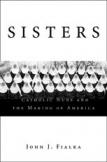Our Earliest Feminists?
After completing a story on the Catholic nuns’ pension fund in 1986, and being intrigued by the lives and contributions of American Catholic sisters, John J. Fialka began work on the book Sisters: Catholic Nuns and the Making of America. Fialka, a reporter for The Wall Street Journal’s Washington bureau, better known for his publications on the Persian Gulf war and economic espionage, was motivated by his own Catholic boyhood and by colleagues who encouraged him to explore this topic further because the lives of these women told a good story.
Although it is evident that Fialka hoped to describe, publicize and laud the historic contributions of women religious, the book unfortunately does not go beyond superficial, although well-meaning, analysis of the sisters’ lives, work and contributions to American society. Even as he attacks the past negative or near-magical stereotypes and caricatures of nuns portrayed by Hollywood and the media, he provides little in-depth analysis and in many cases simply supplants the negative stereotypes with more positive ones, rarely going beyond one-dimensional characters.
Using the journey of the Sisters of Mercy to tell the larger story, Fialka uses Mercy archives and other congregational archives, combining this information with interviews of sisters from a variety of orders. He tells the stories, in a chronological fashion, of well-known individuals like Catherine McAuley, Elizabeth Lange and Katharine Drexel, among others, as well as lesser-known sisters who lived and worked in 19th- and 20th-century America. Unfortunately, the reader has to wonder about the heavily quoted material in the text when the author introduces his endnotes by stating that his notes from each chapter generally pertain to quotations taken from written sources (published and archival) and that other quotations, taken from personal interviews, are not referenced here.
Much of the narrative is journalistic, anecdotal and ahistorical and seldom plumbs the surface. Historians of American women and women religious, who have spent decades doing extensive research, analysis and scholarly writing, will find some astonishing interpretations. With stunning simplicity and inaccuracy, he labels the nuns as America’s first feminists, dates the exhausting treadmill of parish education from the Baby Boom of the 1940’s and 50’s, describes the creation of the Conference of Major Superiors of Women (C.M.S.W.) as spun out from the Sister Formation Conference, interprets the post-Vatican II controversy between the I.H.M.s and Cardinal McIntyre in Los Angeles as a tragic game of ecclesiastical chicken and labels the battles between bishops and nuns as the nation’s longest-lived institutional gender war propelled by insensitive priests and many religious women [who] now style themselves as militant feminists.
Additionally, Fialka demonstrates only passing acquaintance with current and recent scholarship in Catholic history and the history of women religious. Notwithstanding the author’s good intentions, by ignoring much of the relevant and recent scholarship on nuns, he limited his ability to place the sisters’ interesting stories and anecdotes into the larger historical context of either Catholic history or the history of women religious. The stories are interesting but told with little or no context that would allow the reader to develop a deeper and more sophisticated understanding of the historic tensions and adaptations between Catholic religious life and American secular culture. This is unfortunate, because publications from the U.S. Catholic Historian (special issues on Catholic sisters), the Cushwa Center for the Study of American Catholicism (University of Notre Dame) and, most importantly, the Conference on the History of Women Religious (a network of historians and archivists researching the history of women religious) have produced a wonderful array of published books, articles and papers concerning American Catholic sisters, placing their lives and activities within the larger context of women’s history and American social history. As someone who has worked closely with many historians and archivists from this group, I was not amused by Fialka’s statement that if the nuns told their story: They would say sit up straight. Keep your feet under your desks. Be quiet. And pay attention.
Although I applaud Fialka’s goal, wanting to tell the sisters’ American story, Sisters offers the reader little beyond a series of interesting anecdotes. Although the book’s back cover touts it as the first major history of the pivotal role played by nuns in the building of American society, it is neither the first nor a major history of the significant contributions of women religious in their important role as shapers of Catholic culture and American life.
This article also appeared in print, under the headline “Our Earliest Feminists?,” in the March 3, 2003, issue.








